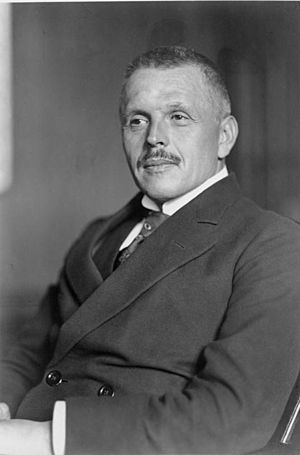Otto Gessler facts for kids
Otto Karl Gessler (born February 6, 1875 – died March 24, 1955) was an important German politician. He was known for his liberal ideas. He served as mayor of cities like Regensburg and Nuremberg. Later, he became Germany's Minister of Defence for a long time, from 1920 to 1928. He played a key role during the Weimar Republic, which was Germany's government after World War I.
Contents
Early Life and Education
Otto Karl Gessler was born in Ludwigsburg, Germany, on February 6, 1875. His father was a non-commissioned officer. Otto finished school in 1894. He then studied law at universities in Erlangen, Tübingen, and Leipzig. He earned his doctorate degree in 1900. After his studies, he worked in the legal field. He held various positions in Bavaria's justice system. In 1903, Gessler married Maria Helmschrott.
Political Journey
Starting in Local Government
Gessler began his political career in local government. He was the mayor of Regensburg from 1910 to 1914. He then became the lord mayor of Nuremberg from 1913 to 1919. He could not serve in the military during World War I due to a physical handicap. However, he managed Nuremberg's city administration very well during the war years. He helped keep peace in Nuremberg and Franconia after the war.
Joining National Politics
Gessler was a close friend of Friedrich Naumann. In November 1918, he helped start the German Democratic Party (DDP). This party believed in liberal ideas and democracy. In October 1919, he became the Minister for Reconstruction in the government led by Gustav Bauer. Gessler supported the new German republic, but he called himself a Vernunftsrepublikaner. This meant he supported the republic because it was the most sensible choice, not because he was a strong believer in it from the start.
Minister of Defence
After a failed attempt to overthrow the government in March 1920 (called the Kapp Putsch), Gessler took over as Minister of Defence. He replaced Gustav Noske, who had to resign. Gessler held this important position for eight years, even though many governments changed during that time.
As Minister of Defence, he worked closely with Hans von Seeckt. Together, they helped build up the new German army, called the Reichswehr. Gessler saw his job as cooperating with the military leaders. The military leaders believed the Reichswehr should be an independent part of the state. From 1920 to 1924, Gessler was also a member of the German parliament, the Reichstag.
In September 1923, there was a political crisis in Bavaria. President Friedrich Ebert declared a state of emergency. As Minister of Defence, Gessler was given special powers. He helped solve the crisis by working with President Ebert, Chancellor Gustav Stresemann, and the military. Later, Gessler created a new department directly under his ministry. This helped shift more political power to the Minister of Defence.
Gessler also served briefly as provisional Minister of the Interior in 1925. In May 1926, he was Vice-Chancellor of Germany for a few days. In January 1927, his party, the DDP, decided not to work with the government led by Wilhelm Marx. To keep his job as Minister of Defence, Gessler left the DDP.
He was forced to resign in January 1928. This happened after some financial issues were found in his ministry. These issues were related to the secret re-arming of the Reichswehr, known as the Phoebus scandal.
Later Roles and Resistance
From 1928 to 1933, Gessler led several important organizations. He was president of the German War Graves Commission, which cares for war graves. He also led the Bund für die Erneuerung des Reiches and the Verein für das Deutschtum im Ausland.
After the Nazis came to power in 1933, Gessler retired from politics. He lived quietly due to poor health. However, during World War II, he joined a resistance group. He had connections with the Kreisau Circle, a group that opposed the Nazis. Gessler was part of the plans for the 20 July plot in 1944. This was a plan to assassinate Adolf Hitler and overthrow the Nazi government. If the plan had succeeded, Gessler was chosen to be a political leader in Munich.
He was arrested two days after the assassination attempt on July 20, 1944. He was held and treated harshly at Ravensbrück concentration camp and other prisons in Berlin. He was finally released in February 1945.
After World War II
After World War II ended, Gessler focused on helping people. In 1949, he became president of the Bavaria Red Cross. He held this position until his death. In 1950, he became president of the German Red Cross. He played a big part in rebuilding this organization after the war. He served as president until 1952. From 1950 to 1955, Gessler was also a member of the Bavarian senate.
Death and Legacy
Otto Karl Gessler died on March 24, 1955, in Lindenberg im Allgäu. In 1958, his memories about his time as Minister of Defence were published after his death. The hospital in Lindenberg is named after him.
Images for kids
See also
 In Spanish: Otto Gessler para niños
In Spanish: Otto Gessler para niños



